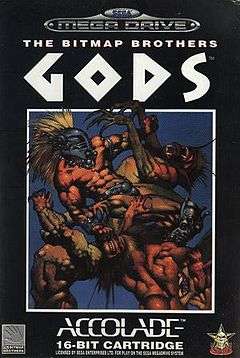Gods (video game)
| Gods | |
|---|---|
|
Packaging for the European Mega Drive version. | |
| Developer(s) | The Bitmap Brothers |
| Publisher(s) |
Accolade Inc. Mindscape Renegade Software |
| Designer(s) | Eric Matthews and Steve Tall |
| Platform(s) | Amiga, MS-DOS, Atari ST, Acorn Archimedes, PC98, Mega Drive/Genesis, Super NES |
| Release date(s) | 1991-92 |
| Genre(s) | Platformer |
| Mode(s) | Single player |
Gods, also known as Gods Into the Wonderful, is a 1991 video game by The Bitmap Brothers where the player is cast as Hercules in his quest to achieve immortality. The game was first made for Amiga and Atari ST computers and then ported for various other platforms. Like other Bitmap Brothers' games, Gods was highly praised by critics thanks to the quality graphics and music.
The enemy AI was praised - it would adapt not only to the player position, but also to his skill. Some rooms contain inaccessible items - smaller "thieves" show up from a passage in the wall, try to grab the item and bring it back to another point in the room or disappear with it. The player is able to obtain the item if they shoot the thief at the correct time. Bonuses are awarded for reaching certain parts of the level under a certain limit of time or number of lives, bringing an object to a room or simply by playing poorly, where the game helps the player.
As was common with Bitmap Brothers, an external musician assured the game score, this time John Foxx as Nation 12.[1] The box cover illustration was designed by the British comic book artist Simon Bisley.
Plot
According to the game's own introduction, "four guardians" have invaded and usurped the citadel of the gods. The gods offer any hero who can succeed in retaking the citadel one favor. The hero who comes forth immediately asks the gods as their favor to be granted a seat among them as an equal. The gods are only comforted by the hope the hero fails. After the last boss is beaten, the gods prove true to their word and the last image is the hero's body becoming a being of light as he ascends to Mount Olympus.
Gameplay
Although Gods might seem a "jump and run" platformer, in this game while precise and timed jumping are required to progress, planning each move carefully yields better results health-wise than attempting to rush through a level, and there are some puzzles (often involving levers and objects) which require the player to go back and forth in the level, since there's only a four space inventory where objects required to get bonuses (such as keys) or to complete a level can be carried. The console versions (particularly the Mega Drive/Genesis version) run at a considerably higher speed, which increases the difficulty level. A Game Boy Advance ROM was also released but is no longer commercially available.[2] The console versions do not share the same opening theme music as the PC versions of the game. They do, however, have background music throughout the game, which is notably missing in the PC versions (The PC version only has background music throughout the game with a Roland LAPC-I).
There are several weapons available in the levels or to buy, and up to three of each can be used simultaneously. It is also possible to vary the focus of the weapons: to destroy more enemies at the same horizontal level as the player, a tight angle is advisable, but in levels with open spaces and enemies in higher places, a diffuse aim might prove more useful. There are also other weapons, such as bouncing axes that can be used to take on enemies at a lower level or fireballs.
There are four levels, each with a Guardian at the end. After completion of a level the player meets a trader, and depending on the wealth accumulated during the game (by catching diamond-shaped jewels or bags) can buy more powerful weapons or items (Xenon 2 Megablast uses the same idea).
Reception
| Reception | ||||||||||||||||||||
|---|---|---|---|---|---|---|---|---|---|---|---|---|---|---|---|---|---|---|---|---|
| ||||||||||||||||||||
Computer Gaming World in 1992 named it one of the year's top four action games for "fast and furious arcade-style action [and] enough exploration and puzzle-solving to raise it above the typical action crowd".[11]
References
- ↑ COMPUTE! ISSUE 147 / DECEMBER 1992 / PAGE 104 from http://www.atarimagazines.com
- ↑ Bitmap Brothers Website
- ↑ Richard Leadbetter; Robert Swan (May 1991), Computer + Video Games (114), pp. 82–84
- ↑ Lesser, Hartley; Lesser, Patricia & Lesser, Kirk (January 1993), "The Role of Computers", Dragon (189): 57–62.
- ↑ Lars Jansson (May 1991), Datormagazin, Vol 1991 No 10, p. 64
- ↑ Dan Slingsby (March 1991), CU Amiga, pp. 34–36
- ↑ David McCandless (April 1991), Zero (18), pp. 43–44
- ↑ Nick Clarkson (July 1991), Amiga Computing (38), pp. 54–55
- ↑ Trenton Webb (June 1991), Amiga Format (23), pp. 54–56
- ↑ Laurence Scotford (March 1991), The One, pp. 48–50
- ↑ "CGW Salutes The Games of the Year". Computer Gaming World. November 1992. p. 110. Retrieved 4 July 2014.
External links
- Gods at MobyGames
- Gods can be played for free in the browser at the Internet Archive
- Gods Atari ST version review, 1992
